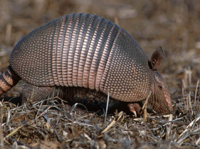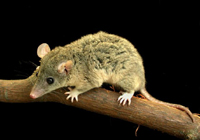Other mammals
Armadillo
 "Without armadillos, there would not be much research on leprosy," - Meyers, Armed Forces Institute
"Without armadillos, there would not be much research on leprosy," - Meyers, Armed Forces Institute
Leprosy was discovered in wild armadillos in southern parts of the United States and in 1974 the armadillo was proposed as a model for biomedical research into leprosy.ANCHOR The course of the disease was similar to that of the disease in humans, with 8 out of 20 armadillos developing the most severe form, lepromatous leprosy, within 5 years following inoculation. Their low body temperature allows the bacteria to grow, and they are the only animals besides humans to naturally develop the lepromatous form of leprosy.
In humans Leprosy affects hands, feet, face and ears – the colder parts of the body – and although it does not cause death, it can cause serious disfigurement. It can be undetected for years before lesions appear and is found throughout the world. All forms of leprosy are caused by the same bacteria. The great variation in the severity of the disease appears to relate to differences between individual immune systems. Attempts to study the bacteria in vivo using other animal models have failed, as have attempts to grow the bacteria in culture.
Armadillos are not affected in the same way as humans. Their low body temperature means that leprosy attacks the central organs such as the brain and spinal cord, causing death.ANCHOR The nine-banded armadillo has now become the principle source of M. leprae in research and medicine. Research on the armadillo model allowed the development of an experimental leprosy vaccine, which was purified from killed leprae bacteria. WHO hoped that this vaccine would eventually eliminate leprosy altogether.ANCHOR Although the vaccine programme eventually proved impractical, and was closed down, studying the purified bacteria allowed a much greater understanding of leprosy.
Prior to the vaccine programme there was some drug treatment available for sufferers, but as M. leprae quickly develops resistance, drugs must be taken in combinations for effective treatment, and susceptibility to leprosy varies greatly between people. Drug treatment has been greatly refined by research on this animal model. Substances refined from the purified bacteria are now used as diagnostic tools to predict an individual’s susceptibility to leprosy and to plan a course of treatment.
Nine-banded armadillos are the only mammals to produce double twins – they give birth to four identical offspring which share the same placenta during development.ANCHOR Because of this armadillos have been used to study multiple births and other reproductive issues. The four identical offspring produced by armadillos are of great interest to scientists as they provide excellent experimental controls for genetic factors. Armadillos have been used in several research fields, including skin and organ transplants and investigations of cancer-causing agents.
Short-tailed grey opossum
 These small animals are around the size of a hamster when fully grown. They are one of many species of the pouchless marsupials, opossums. While most marsupials are found in Australia, grey short-tailed opossums (Monodelphis domestica) are common in parts of South America. They are solitary, unsociable animals, which occasionally take up residence in houses. The species name refers to the good fortune associated with their presence in a home, which they efficiently keep free of insects and vermin.
These small animals are around the size of a hamster when fully grown. They are one of many species of the pouchless marsupials, opossums. While most marsupials are found in Australia, grey short-tailed opossums (Monodelphis domestica) are common in parts of South America. They are solitary, unsociable animals, which occasionally take up residence in houses. The species name refers to the good fortune associated with their presence in a home, which they efficiently keep free of insects and vermin.
The opossum is used worldwide in research, although it is more common in the laboratories of the United States than Europe. They can be bred in captivity, however the aggressive nature of M domestica.ANCHOR In May 2007 M domestica became the first marsupial to have its genome sequenced. Marsupials are the closest relatives of placental mammals, which include humans..ANCHOR Comparison of this genome with human DNA will give new insights into how humans evolved, how our DNA is organised and how placental mammals differ from other animals.
The structure of the opossum genome is very different to humans. For example, genes are organised into nine chromosomes, whilst humans have 23. However, studies so far show that most of the 2,000 marsupial genes have equivalents in humans.
These opossums are the only mammal known to develop melanoma skin cancer solely in response to ultra-violet light..ANCHOR As most human skin cancers develop in this way, this animal is important for studying the increasing number of skin cancer cases, and for finding new methods of prevention and treatment.
Marsupials have a very short gestation period and give birth to tiny, under-developed young – the equivalent of a six week old human foetus. Baby opossums are the size of a grain of rice when they are born and attach themselves securely to the mother’s teats. Baby marsupials have the ability to regenerate a crushed or severed spinal cord until they are around 10 days old..ANCHOR Studying the cellular mechanisms that allow this will improve understanding of nervous system development, and may help to find new therapies for spinal cord injuries.
References
- 1. Sorrs, E.E. et al. (1974) Science 183 (4127), 851
- 2. Sorrs, E.E. (1982) The astonishing armadillo, National Geographic 161 (6), 820-830
- 3. Mill Hill essays 2003, Armadillos and leprosy: http://www.nimr.mrc.ac.uk/millhillessays/2003/armadillo/
- 2. Sorrs, E.E. (1982) The astonishing armadillo, National Geographic 161 (6), 820-830
- 4. Skeoch, M (2008) Grey short tailed opossums (Monodelphis domestica). Animal Technology and Welfare 7 (1), 13-16
- 5. Mikkelsen, T et al. (2007) Genome of the marsupial Monodelphis domestica reveals innovation in non-coding sequences. Nature 447, 167-177
- 6. Kusewitt, DF, Applegate, LA, Ley, RD (1991) Ultraviolet radiation-induced skin tumors in a South American opossum (Monodelphis domestica). Vet Path 28, 55–65
- 7. Wintzer, M et al. (2004) Strategies for identifying genes that play a role in spinal cord regeneration. J Anat. 204 (1), 3-11
Last edited: 21 August 2014 09:51
